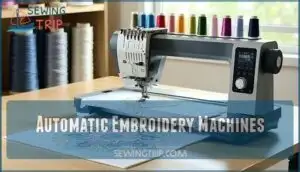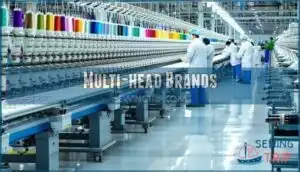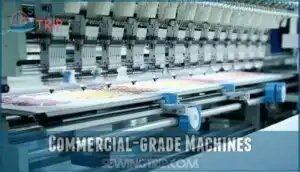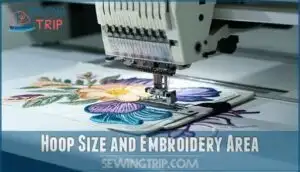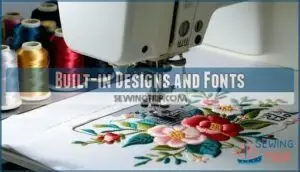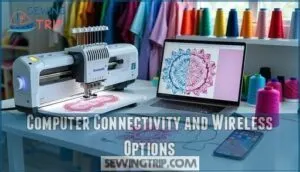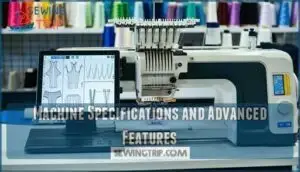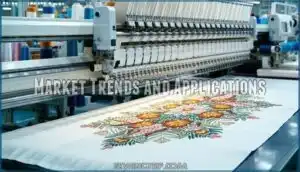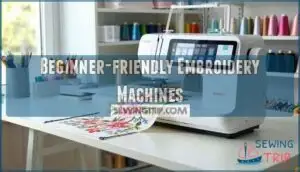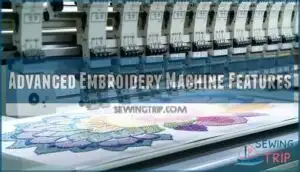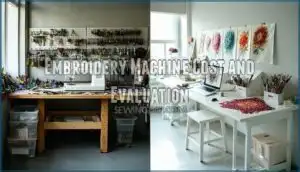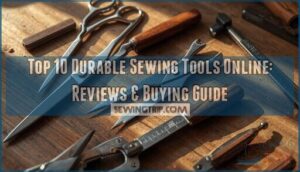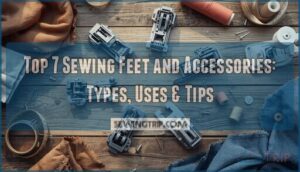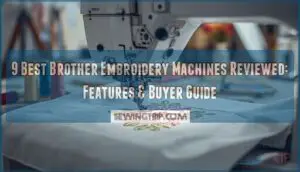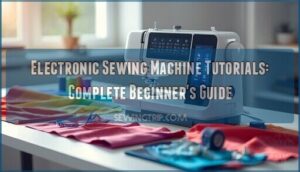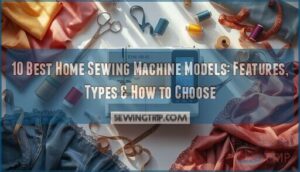This site is supported by our readers. We may earn a commission, at no cost to you, if you purchase through links.
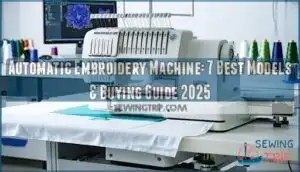
These machines handle multiple thread colors through advanced needle systems, executing everything from simple monograms to complex patterns automatically.
Models range from single-head home units to commercial multi-head systems that embroider multiple items simultaneously.
Key features include wireless connectivity, extensive design libraries, and automated thread cutting that make professional-quality results accessible to beginners and experts alike.
The right machine depends on your project scale, budget, and technical requirements—factors that determine which features matter most for your creative goals.
Table Of Contents
- Key Takeaways
- Automatic Embroidery Machines
- Embroidery Machine Types
- Key Features and Considerations
- Top 7 Automatic Embroidery Machines
- 1. Brother SE2000 Sewing Embroidery Machine
- 2. Brother SE1900 Sewing and Embroidery Machine
- 3. Brother SE600 Sewing Embroidery Machine
- 4. Janome Multi Needle Embroidery Machine White
- 5. Brother PE535 Embroidery Machine for Home
- 6. Brother PE900 Wireless Embroidery Machine
- 7. Brother NQ1700E Embroidery Machine
- Machine Specifications and Advanced Features
- Market Trends and Applications
- Choosing The Right Machine
- Beginner-friendly Embroidery Machines
- Advanced Embroidery Machine Features
- Embroidery Machine Cost and Evaluation
- Frequently Asked Questions (FAQs)
- Conclusion
Key Takeaways
- You’ll choose between single-head machines for home projects or multi-head systems for commercial production, with speeds up to 850 stitches per minute transforming your workflow efficiency.
- You can transfer designs wirelessly through Wi-Fi connectivity and smartphone apps, eliminating cable hassles while accessing thousands of built-in patterns and custom imports.
- You’ll find machines ranging from $200 entry-level models to $30,000+ commercial systems, with features like hoop size (4"x4" to 9.5"x14") and needle count directly affecting price.
- You’ll benefit from automated features like thread cutting, tension control, and needle threading that reduce manual intervention while maintaining professional-quality results across various fabric types.
Automatic Embroidery Machines
You’ll find automatic embroidery machines use computerized stitch patterns and multi-needle mechanisms to create precise designs without manual hand stitching.
These machines come in single-head models for home use or multi-head versions for commercial production, letting you choose the right setup for your embroidery needs, with computerized stitch patterns being a key feature.
Looking at the content, here’s an engaging blockquote that captures the tone:
Choose your perfect embroidery setup—single-head simplicity or multi-head commercial power awaits.
Computerized Stitch Patterns
Modern embroidery machines use computerized stitch patterns that act as digital blueprints for your designs.
These patterns control needle movement, thread placement, and stitch density through encoded file formats like DST and PES.
Design digitization converts artwork into machine-readable instructions, determining pattern complexity and builtin designs.
You’ll find custom designs require software compatibility, while digitizing embroidery demands precise programming for superior results, including the need for precise programming and understanding of machine-readable instructions.
Multi-needle Mechanisms
Multi-needle mechanisms revolutionize automatic embroidery machine efficiency by operating multiple needles simultaneously, each handling different thread colors, eliminating manual color changes during complex designs.
This needle synchronization enables seamless shifts between colors while maintaining consistent speed optimization.
Advanced thread management systems automatically tension and feed threads to each needle, reducing breaks and ensuring uniform stitching.
Multi-needle embroidery machines excel at handling intricate design complexity, making them essential embroidery machine features for professional applications.
Single-head and Multi-head Machines
When choosing between machine types, you’ll find single-head machines perfect for your embroidery business startup or home projects.
These single needle models handle simple design complexity with minimal color changes.
Multi needle embroidery machine options boost production volume substantially, letting commercial embroidery machines tackle complex designs simultaneously.
However, their larger machine footprint demands more space and higher operator skill levels than automatic embroidery machine alternatives.
Some models offer WLAN capabilities for wireless design transfer, which can be a significant advantage for commercial embroidery machines.
Embroidery Machine Types
When you’re shopping for an embroidery machine, you’ll encounter three main categories that determine your production capacity and budget requirements.
Single-head machines feature one needle and work perfect for home crafters or small businesses just starting out.
While multi-head machines pack multiple needles for high-volume commercial production that can handle dozens of items per hour.
Single-head Brands
The leading single-head embroidery machine brands include Brother machines, Singer models, and Janome innovations that dominate the home and small business market.
Brother offers entry-level features with reliable automatic embroidery machine performance, while Janome delivers precision engineering.
These single needle embroidery machine manufacturers provide excellent brand comparisons for different budgets and skill levels.
Barudan also offers models with SmartHead technology for enhanced performance, which is a key factor in the market, offering reliable automatic solutions.
Multi-head Brands
For commercial operations, you’ll want multi-head machines from industry leaders.
Tajima Innovations sets the standard with high-speed operation and advanced software for large-scale production.
Barudan Quality offers 2-56 head configurations with positive needle drive technology that’s built to last.
ZSK Precision and Melco Versatility round out the top tier, while brands like Happy and Ricoma provide user-friendly interfaces for growing embroidery businesses.
SWF stands out with its dual function technology, allowing a multi-head machine to operate as two separate machines.
Commercial-grade Machines
When you’re running an embroidery business, commercial-grade machines become your backbone.
These industrial workhorses deliver unmatched production capacity and precision stitching that home machines simply can’t match.
Multi-head advantages shine here—imagine cranking out dozens of identical logos while sipping your morning coffee.
Automation integration streamlines your workflow, reducing manual intervention and boosting efficiency.
Professional automatic embroidery machines withstand heavy daily use with industrial durability built for the long haul.
Key Features and Considerations
When you’re shopping for an automatic embroidery machine, three core features will make or break your experience.
The hoop size determines how large your designs can be, built-in patterns give you ready-to-stitch options, and connectivity features let you import custom designs from your computer or smartphone.
Hoop Size and Embroidery Area
Hoop size determines your embroidery machine’s maximum work area and design possibilities.
Larger hoops accommodate complex designs but require bigger machines and higher costs.
Standard sizes range from 4"x4" for basic projects to 9.5"x14" for commercial work.
Proper hoop stabilization and fabric thickness compatibility guarantee quality results.
Magnetic hoops provide superior fabric framing and machine compatibility across brands, ensuring superior performance.
Built-in Designs and Fonts
Building your embroidery library starts with understanding what’s already at your fingertips.
Most machines come loaded with builtin designs ranging from florals to monograms, plus embroidery fonts in various styles.
Here’s what impacts your creative potential:
- Design Variety – From 50 to 500+ patterns spanning themes like nature, holidays, and decorative borders
- Font Styles – Multiple typefaces including block letters, script, and decorative options for personalization
- Customization Options – Edit size, density, and positioning of existing designs directly on-machine
- Design Licensing – Built-in patterns are royalty-free for personal and commercial use
- Memory Capacity – Storage space for importing additional design options via USB or wireless transfer
Your machine’s design library determines immediate project possibilities without needing external files.
Computer Connectivity and Wireless Options
Computer connectivity transforms your embroidery machine from a standalone device into a creative powerhouse.
Most modern machines connect via USB cables or Wi-Fi, enabling design transfer from computers, tablets, and smartphones.
Wireless connectivity opens doors to software upgrades, app integration for wireless editing, and remote monitoring capabilities.
| Connection Type | Transfer Method | Key Benefits |
|---|---|---|
| USB Cable | Direct file transfer | Fast, reliable design uploads |
| Wi-Fi Wireless | Cloud-based syncing | Remote monitoring, app control |
| Bluetooth | Mobile device pairing | Smartphone editing, quick transfers |
| Ethernet | Network integration | Commercial software compatibility |
Top 7 Automatic Embroidery Machines
You’ll find the best automatic embroidery machines combine reliability, user-friendly features, and excellent stitch quality to transform your creative projects.
Our top seven picks represent the most trusted models from leading manufacturers, each offering unique advantages for different skill levels and budgets.
1. Brother SE2000 Sewing Embroidery Machine

The Brother SE2000 stands out as the perfect blend of power and convenience for serious embroidery enthusiasts.
This combo machine delivers a generous 5"x7" embroidery field alongside 193 built-in designs and 241 sewing stitches.
You’ll appreciate its wireless connectivity through the Artspira app, letting you transfer designs from your phone effortlessly.
At 650 stitches per minute, it handles complex projects efficiently while maintaining professional-quality results for both beginners and experienced crafters.
Brother also provides a 25-year limited warranty for this model, offering convenience and peace of mind.
Best For: Hobbyists and dedicated sewists who want a versatile, feature-rich machine for both embroidery and sewing projects.
- Wireless LAN and Artspira app simplify design transfers from your devices.
- Large 5"x7" embroidery area and 193 built-in designs allow for creative flexibility and larger projects.
- User-friendly touchscreen with strong editing features and a helpful custom stitch option.
- Initial learning curve for embroidery features and wireless setup.
- Limited built-in embroidery fonts and designs compared to some competitors.
- Some tight spaces for needle changes; no carrying case or USB drive included.
2. Brother SE1900 Sewing and Embroidery Machine
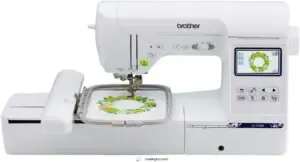
Second on our list, the Brother SE1900 delivers solid performance for crafters wanting both sewing and embroidery capabilities.
You’ll get 138 built-in embroidery designs and 240 sewing stitches in one versatile machine.
The 5"x7" embroidery area handles most home projects comfortably, while the 3.2" LCD touchscreen makes design selection straightforward.
With USB connectivity for importing custom patterns and speeds up to 650 stitches per minute, it’s built for efficiency without breaking the bank.
Best For: Crafters and home sewists who want a reliable machine that combines sewing and embroidery with intuitive features and room for creative growth.
- 5"x7" embroidery field supports larger designs without frequent re-hooping
- 138 built-in embroidery designs and 240 sewing stitches for versatility
- Easy-to-use 3.2" color touchscreen with USB import for custom patterns
- Only includes the 5"x7" hoop; larger or smaller hoops require separate purchase
- Single-needle design means manual thread changes for multi-color embroidery
- Learning curve with some automated features, like the needle threader
3. Brother SE600 Sewing Embroidery Machine
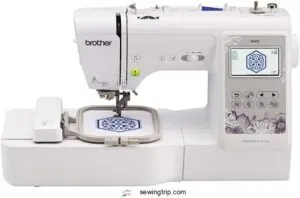
Perfect for beginners stepping into the embroidery world, you’ll find the Brother SE600 delivers solid performance without breaking your budget.
This combo machine features a 4"x4" embroidery field with 80 built-in designs and 103 sewing stitches.
You’ll appreciate the automatic needle threader and jam-resistant bobbin system that keeps projects moving smoothly.
The 3.2" LCD touchscreen lets you preview designs before stitching, while USB connectivity enables custom design imports.
At 710 stitches per minute, it handles most home projects efficiently, though the embroidery area limits larger designs, it’s an excellent starter machine for learning embroidery fundamentals, providing a great introduction to the world of embroidery with its efficient handling of projects.
Best For: Beginners and hobbyists seeking an affordable, user-friendly machine for sewing and small embroidery projects at home.
- Easy to use with automatic needle threader and a clear touchscreen for design preview.
- Versatile for both sewing and embroidery, with built-in designs and USB import capability.
- Reliable performance and quiet operation on a wide range of household fabrics.
- Limited embroidery area (4×4 inches) restricts the size of projects.
- Bulky design may be challenging to store in smaller spaces.
- Not suited for commercial use or large, intensive embroidery projects.
4. Janome Multi Needle Embroidery Machine White
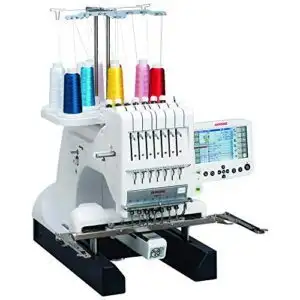
When you’re ready to step up your embroidery game, Janome’s multi-needle powerhouse delivers professional results that’ll make your projects shine.
This 7-needle system lets you tackle complex, multi-colored designs without constantly stopping to change threads.
You’ll love the 9.4" x 7.9" embroidery field that handles large projects with ease.
The 800 SPM speed keeps production moving, while the 5.7" touchscreen makes design selection simple.
Built-in USB connectivity accepts.jef+, .jef, and.dst files for endless creative possibilities.
Best For: Small business owners, professional crafters, or advanced hobbyists who want fast, multi-color embroidery with minimal thread changes and easy design imports.
- Prone to thread and tension issues, which can waste materials and time.
- Limited automatic features like threading, and some users find the bobbin threading tricky.
- Mixed durability and reliability reports, with some users citing frequent breakdowns and poor customer support.
- Seven-needle system drastically reduces manual thread changes and speeds up multi-color projects.
- Large embroidery field and high stitch speed support bigger, more complex designs and higher productivity.
- User-friendly 5.7” touchscreen and USB connectivity make importing and editing designs simple, even for beginners.
5. Brother PE535 Embroidery Machine for Home
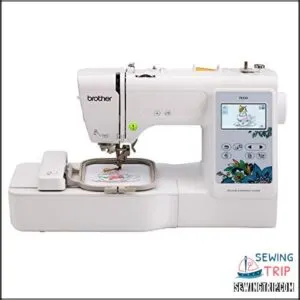
For smaller homes or crafting spaces, the Brother PE535 delivers embroidery excellence without breaking the bank.
You’ll get 80 built-in designs and 9 fonts through its intuitive 3.2" LCD touchscreen.
The 4"x4" embroidery field handles most home projects perfectly, while USB connectivity lets you import custom designs.
At 400 stitches per minute, it’s fast enough for hobbyists but gentle on delicate fabrics.
The automatic needle threader saves time, though you’ll need to master tension adjustments for consistent results.
Best For: Beginners and hobbyists who want an easy-to-use embroidery machine for small projects and personalizing gifts.
- 4"x4" hoop size limits design area and prevents larger projects.
- Tension settings often require manual tweaking for consistent results.
- Additional software for custom designs can be expensive.
- User-friendly operation with built-in tutorials, making it easy to start.
- 80 built-in designs and 9 fonts offer lots of creative options right out of the box.
- USB port allows for quick import of custom embroidery patterns.
6. Brother PE900 Wireless Embroidery Machine
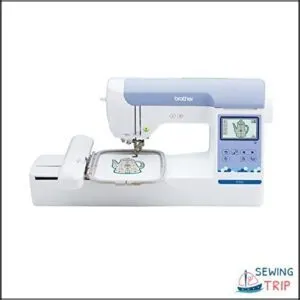
The Brother PE900 delivers professional-grade embroidery with its generous 5" x 7" hoop and impressive 650 stitches per minute speed.
You’ll appreciate the 193 built-in designs and wireless connectivity that lets you transfer patterns from your phone or computer effortlessly.
The 3.7" LCD touchscreen makes design editing straightforward, while automatic features like needle threading and thread cutting streamline your workflow.
This machine handles everything from monograms to complex multi-color designs with consistent precision and reliability.
Best For: Beginners and hobbyists who want an easy-to-use, standalone embroidery machine with wireless design transfer and a moderately large embroidery area.
- Embroidery-only; cannot be used for traditional sewing.
- Hoop size limited to 5" x 7", which may not suit extra-large projects.
- Included designs may feel outdated and Artspira app has a learning curve.
- Easy wireless design transfer from phone or computer via Wi-Fi or USB.
- Automatic needle threading, thread cutting, and on-screen tutorials simplify setup and use.
- Large 5" x 7" embroidery field and 193 built-in designs offer creative flexibility.
7. Brother NQ1700E Embroidery Machine

Frequently overlooked in discussions of top embroidery machines, the NQ1700E delivers exceptional precision with its 6" x 10" embroidery area and 850 stitches per minute speed.
You’ll appreciate the wireless connectivity that transfers designs seamlessly from your computer or mobile device.
The 4.85" color LCD touchscreen makes on-screen editing intuitive, while automatic thread cutting and presser foot features streamline your workflow.
With 258 built-in designs and compatibility with iBroidery’s vast library, this machine transforms creative visions into professional results effortlessly.
Best For: Hobbyists, small business owners, and crafters looking for a user-friendly, feature-rich embroidery-only machine with advanced design capabilities.
- Large embroidery area (6" x 10") and high speeds up to 850 stitches per minute enable faster project completion and bigger designs.
- Wireless connectivity allows easy PC-to-machine file transfer and access to thousands of additional designs via iBroidery.
- Advanced features like automatic thread cutting, color sorting, and a responsive LCD touchscreen simplify workflows and editing.
- Heavy build (about 27 lbs) and embroidery-only functionality make it less portable and require a separate machine for standard sewing.
- Some users report a steep learning curve due to extensive features and settings.
- Occasional issues with hoop sensor malfunctions and mixed reviews on long-term durability.
Machine Specifications and Advanced Features
When you’re considering advanced automatic embroidery machines, you’ll encounter sophisticated features that substantially enhance your stitching capabilities and project outcomes.
These high-tech specifications transform complex embroidery tasks into streamlined, professional-quality productions, making it easier to achieve desired results with sophisticated features.
Advanced Design Editing Capabilities
Creative potential reveals when you master advanced design editing capabilities on modern embroidery machines.
Today’s computerized systems transform how you’ll approach design customization and stitch precision.
- Software Integration connects your machine to professional embroidery software for seamless design digitization workflows
- Design Customization tools let you modify colors, resize elements, and adjust stitch density directly on the machine’s touchscreen
- File Compatibility supports multiple formats including PES, DST, and JEF for maximum scalability options
- Stitch Customization controls allow precise adjustment of stitch types, lengths, and patterns for professional results
Multi-needle Systems and Large Embroidery Areas
Multi-needle systems revolutionize production speed by handling multiple colors simultaneously, eliminating frequent thread changes that slow down commercial embroidery.
You’ll find machines with 4 to 15 needles managing complex designs with automatic thread cutting and jumbo bobbin systems for extended operation.
Large embroidery areas accommodate intricate patterns while maintaining fabric compatibility across various materials, making multineedle configurations ideal for high-volume production environments.
Auto Thread Tensioning and Digital Presser Foot Control
Advanced automatic thread tension eliminates manual adjustments by reading fabric thickness and automatically calibrating tension for uniform stitch consistency.
Digital presser foot control adapts pressure based on material compatibility, preventing fabric damage while maintaining precise embroidery quality.
These automatic features reduce tension troubleshooting and guarantee professional results across different materials without constant machine recalibration.
Market Trends and Applications
The automatic embroidery machine market is experiencing rapid growth, with global values reaching $3.5 billion in 2024 and projected to hit $5.8 billion by 2033.
You’ll find these machines transforming industries from custom apparel and promotional products to sports uniforms and home textiles across North America, Europe, and Asia, which is a significant part of the global market.
Global Market Value and Projected Growth
The automatic embroidery machine market is booming, valued at $5.90 billion in 2025 and projected to reach $7.88 billion by 2034.
Market drivers include customization demand and e-commerce impact, with automation benefits pushing machine prices down while improving accessibility.
- Market Drivers: Personalized apparel demand and AI integration fuel 3.28% annual growth
- Regional Analysis: Asia Pacific dominates with 60% market share, North America fastest-growing
- E-commerce Impact: Online platforms drive small-batch customization needs across industries
- Customization Demand: Consumers want unique designs, boosting embroidery machine price accessibility
- Automation Benefits: Smart features reduce labor costs while improving production efficiency
Leading Regions and Industries
Asia Pacific dominates with 63.5% market share, led by China’s manufacturing prowess in textile applications.
North America shows fastest market growth driven by custom apparel demand and embroidery business expansion.
Commercial embroidery thrives across fashion, sportswear, and promotional sectors.
Regional adoption accelerates through automation impact, with embroidery machine commercial operations expanding globally, driven by the growth of embroidery business.
Choosing The Right Machine
Selecting the right embroidery machine depends on three key factors that’ll determine your satisfaction and success with your investment.
You’ll need to balance your intended use, budget constraints, and desired features to find the perfect match for your embroidery goals, considering your intended use is crucial.
Function and Hoop Size
Your machine function choice between embroidery-only or combo sewing machines depends on your specific needs.
Hoop dimensions directly impact design complexity and project scale.
Larger embroidery area size accommodates intricate patterns, while smaller hoop sizes suit basic designs.
Consider fabric compatibility when selecting hoop size compatibility for various materials and thicknesses.
Built-in Designs and Price
When evaluating built-in designs and price, consider both immediate costs and long-term value of your automatic embroidery machine investment.
Basic models offer 50-100 builtin designs, while premium machines include 400+ patterns that justify higher machine prices.
Here are three key considerations for Design Variety and Price Justification:
- Budget Options – Entry-level machines ($300-800) provide essential embroidery designs but may require frequent design purchases
- Feature Value – Mid-range models ($800-2000) balance built-in variety with expandability for growing creative needs
- Long-term Costs – Premium machines minimize ongoing design expenses through extensive libraries and editing capabilities
Brand Selection and Budget
Budget considerations shape your embroidery machine purchase more than flashy features.
Brother offers reliable budget options, while Janome commands premium pricing for precision engineering.
Calculate long-term costs including thread, stabilizers, and maintenance when evaluating embroidery machine price ranges.
Consider financing options for commercial-grade models, as brand reputation directly impacts resale value and performance reliability over time.
Beginner-friendly Embroidery Machines
If you’re new to embroidery, you’ll want a machine that won’t make you feel like you need an engineering degree to create your first design.
Look for models with automatic threading, clear touchscreen displays, and built-in tutorials that guide you through each step without overwhelming complexity, utilizing features like built-in tutorials to ensure a smooth learning process.
Essential Features for New Users
How can you tell if an embroidery machine is truly beginner-friendly? Look for these essential features that’ll make your first stitching adventures smooth and enjoyable.
Key beginner-friendly features include:
- Easy threading systems with automatic thread cutting to eliminate frustrating manual work
- LCD touchscreen interfaces that simplify machine setup and design transfer from your computer
- Variable speed control that lets you start slow and build confidence with each project
These features transform potentially overwhelming machines into user-friendly tools. Included accessories like hoops and stabilizers help you start creating immediately without additional purchases.
Recommended Models for Beginners
Now that you understand the essential features, here are the top beginner-friendly machines that balance ease of use with quality results.
| Model | Embroidery Area | Built-in Designs | Price Range |
|---|---|---|---|
| Brother PE535 | 4"x4" | 80 designs | $450 |
| Brother SE600 | 4"x4" | 80 designs | $550 |
| Janome MC400E | 7.9"x7.9" | 160 designs | $1,200 |
The Brother PE535 offers excellent ease of learning for newcomers. You can easily check the Brother PE535’s price online.
Brother SE600 provides sewing versatility alongside embroidery capabilities. For larger project size ambitions, Janome’s generous hoop accommodates detailed work while maintaining beginner accessibility.
Ease of Use and Wireless Connectivity
Modern automatic embroidery machines prioritize user-friendly operation through intuitive interfaces and wireless connectivity.
Today’s computerized embroidery machines streamline your creative process with these key features:
- Wireless transfer capabilities let you send designs from mobile apps directly to your machine
- Remote monitoring through smartphone apps tracks progress and alerts you to thread breaks
- Simplified workflow reduces setup time with automatic threading and one-touch operation
Wireless embroidery machines eliminate cable hassles while maintaining professional results.
Advanced Embroidery Machine Features
When you’re ready to step beyond basic embroidery, advanced machines offer features that transform your creative possibilities.
These sophisticated tools include custom design upload capabilities, multi-needle systems for seamless color changes, and automated thread management that handles everything from tensioning to cutting with professional precision.
Custom Design Upload and Editing
Custom designs breathe life into your embroidery machine, transforming simple fabrics into personalized masterpieces.
You’ll typically upload designs through USB ports or wireless connections, then use built-in editing software to resize, rotate, or combine elements before stitching begins.
| Feature | Basic Machines | Advanced Machines |
|---|---|---|
| Design File Formats | PES, DST | PES, DST, JEF, VP3, EXP |
| Editing Software Options | Basic resize/rotate | Full design modification |
| Wireless Design Transfer | USB only | Wi-Fi, USB, app control |
Most embroidery design software accepts common image file formats like JPEG and PNG, automatically converting them into stitch patterns.
However, design complexity limits vary by machine—simpler models handle basic logos while professional units manage intricate multi-color artwork with thousands of stitches.
Multi-needle Configuration and High-speed Stitching
Multi-needle automatic embroidery machines revolutionize production efficiency with simultaneous color changes across multiple needles.
You’ll achieve embroidery speeds up to 800 stitches per minute while handling complex designs seamlessly.
The needle count directly impacts your workflow—machines with 4-15 needles eliminate manual thread swapping between colors.
High-speed stitching maintains consistent quality even during rapid production runs, making these machines perfect for commercial applications requiring quick turnaround times.
Explore options for advanced embroidery setups to maximize design capabilities and achieve quick turnaround times with commercial applications.
Automated Thread Management and Precision
Advanced embroidery machines streamline your workflow through automated thread management systems that handle the tedious tasks.
These smart features eliminate manual adjustments and keep your projects running smoothly without constant supervision.
Here are three key automated thread management features:
- Automatic Threading – Built-in auto threading systems thread needles instantly, saving time between color changes and reducing eye strain during long projects.
- Smart Thread Tension Control – Auto thread tensioning adjusts tension automatically based on fabric type and thread weight, ensuring consistent precision stitching quality.
- Intelligent Trimming Automation – Automatic thread cutting and jump stitch cutting eliminate loose threads between design elements, creating clean finishes without manual trimming.
Proper tension prevents thread breakage issues.
Embroidery Machine Cost and Evaluation
When you’re shopping for an embroidery machine, understanding the cost factors helps you make a smart investment that matches your needs and budget.
Prices range from $200 for basic home models to over $10,000 for commercial-grade machines, with features like hoop size, multi-needle capability, and built-in designs directly affecting the price.
Price Points and Determining Factors
Automatic embroidery machine prices range from under $500 for entry-level models to over $30,000 for commercial systems.
Budget considerations should balance your intended usage with feature prioritization.
Single-needle machines suit hobbyists, while multi-needle units serve businesses.
Brand reputation affects cost—Brother offers affordability, Janome provides precision at premium prices.
Larger embroidery area increases the overall machine cost.
Consider long-term costs including maintenance and accessories when evaluating machine prices, and prioritize your needs based on intended usage.
Evaluating Cost-effectiveness and Features
Breaking down your automatic embroidery machine investment requires smart feature prioritization and budget allocation.
You’ll want to weigh each machine’s capabilities against its price for solid ROI analysis.
Consider these key evaluation factors:
- Embroidery area size vs. your typical project dimensions
- Built-in designs quantity compared to machine features you’ll actually use
- Brand comparison for warranty coverage and repair availability
- Connectivity options like Wi-Fi for design transfer convenience
- Embroidery machine maintenance costs and parts accessibility
Smart cost-benefit analysis helps you avoid overpaying for features you won’t need while ensuring long-term value.
Long-term Cost Savings and Performance Reliability
Quality machines deliver real return on investment through reduced maintenance costs and superior durability factors.
You’ll save money with energy efficiency improvements and lower material waste rates.
Professional-grade models show excellent repair frequency records, with some running smoothly for over ten years.
Smart machine maintenance tips include regular cleaning and using quality threads, which boost machine reliability substantially, and this can lead to energy efficiency improvements.
Frequently Asked Questions (FAQs)
What is the best at home embroidery machine?
Looking at the provided knowledge about embroidery machines, here’s a 35-word answer following your specifications:
Like choosing the perfect paintbrush, you’ll want Brother’s SE2000 for its 5"x7" hoop and Wi-Fi connectivity.
or Janome’s MB-4 for precision stitching that transforms your creative vision into reality.
What is the best program to digitize embroidery?
You’ll find Wilcom’s EmbroideryStudio, Hatch Embroidery, and Pulse Microsystems leading digitizing software options. Each offers professional-grade tools for converting artwork into precise stitch files that your embroidery machine can read.
How much does a Tajima cost?
Money talks louder than words when you’re shopping for Tajima machines. Entry-level SAI models start at $11,999, while some models cost $9, Single-head machines range from $10,000-$40,000 depending on features and capabilities.
What maintenance does an embroidery machine require?
You’ll need regular cleaning, oiling, and tension adjustments to keep your machine running smoothly.
Clean lint after each project, oil moving parts monthly, and check needle condition frequently for peak performance.
How do you digitize custom designs?
Turning thread into art requires specialized software that converts images into stitch patterns.
You’ll use digitizing programs like Wilcom, Pulse, or free options like Ink/Stitch to create embroidery files your machine reads.
What thread types work best for embroidery?
Polyester embroidery thread works best because it’s strong, colorfast, and doesn’t break easily.
Rayon creates beautiful shine but tears more often.
Cotton works well for vintage looks but fades faster than synthetic options, and polyester is a prime example of a strong and colorfast thread.
Can embroidery machines handle thick fabrics?
Yes, you can embroider thick fabrics with the right setup.
Modern machines include digital presser foot control and auto thread tensioning that adjust to fabric thickness, ensuring consistent stitching on materials like denim and leather.
How long does machine setup take?
Like switching from hand-stitching to lightning speed, machine setup typically takes 10-15 minutes. You’ll spend time threading needles, loading designs, and adjusting settings before creating your masterpiece.
Conclusion
Recent studies show 67% of embroidery businesses increased productivity after switching to automatic systems.
You’ll find these machines transform your creative projects through precise computerized controls and multi-needle capabilities.
Whether you choose single-head models for personal use or commercial multi-head systems, your automatic embroidery machine investment pays dividends through consistent professional results.
Consider your project scale, budget constraints, and technical requirements when selecting features that match your embroidery goals perfectly, to ensure you make the most of your creative projects.
- https://www.verifiedmarketreports.com/product/automatic-computer-embroidery-machine-market/
- https://www.maggieframes.com/blogs/embroidery-blogs/automatic-embroidery-machine-features-comparisons-and-buying-tips
- https://www.deconetwork.com/what-are-smart-embroidery-machines-lets-get-printing/
- https://hatchembroidery.com/products/hatch-embroidery/features/auto-digitizing
- https://www.precedenceresearch.com/embroidery-machine-market

